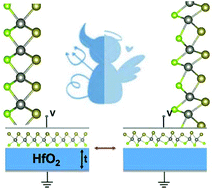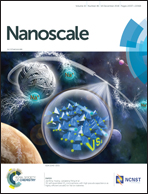Janus monolayer of WSeTe, a new structural phase transition material driven by electrostatic gating†
Abstract
Phase transition materials are widely exploited in sensors, switches, and information storage devices. However, the dynamic control of structural phase transitions in low-dimensional materials is rarely reported, except for the recent demonstration of semiconductor–semimetal transition in monolayer MoTe2 modulated by electrostatic gating. Here, based on density functional theory calculations we screen in the Janus family of transition metal dichalcogenides, MXY where M = Mo or W, X/Y = S, Se, or Te, for new two-dimensional phase transition materials. We find that the Janus monolayer of WSeTe undergoes reversible phase transitions modulated by electrostatic gating, owing to the small energy difference between H and T′ phases, ET′ − EH = 48 meV. The gate voltage of 2.0 V (with high dielectric gating the injected charge is ∼1013 cm−2) is required to trigger the semiconductor–semimetal transition in WSeTe. The kinetic barrier for both forward and backward phase transitions is ∼0.66 eV, which is significantly lower than that in MoTe2, leading to three orders of magnitude increase in the transition rate and much more rapid response of devices.



 Please wait while we load your content...
Please wait while we load your content...